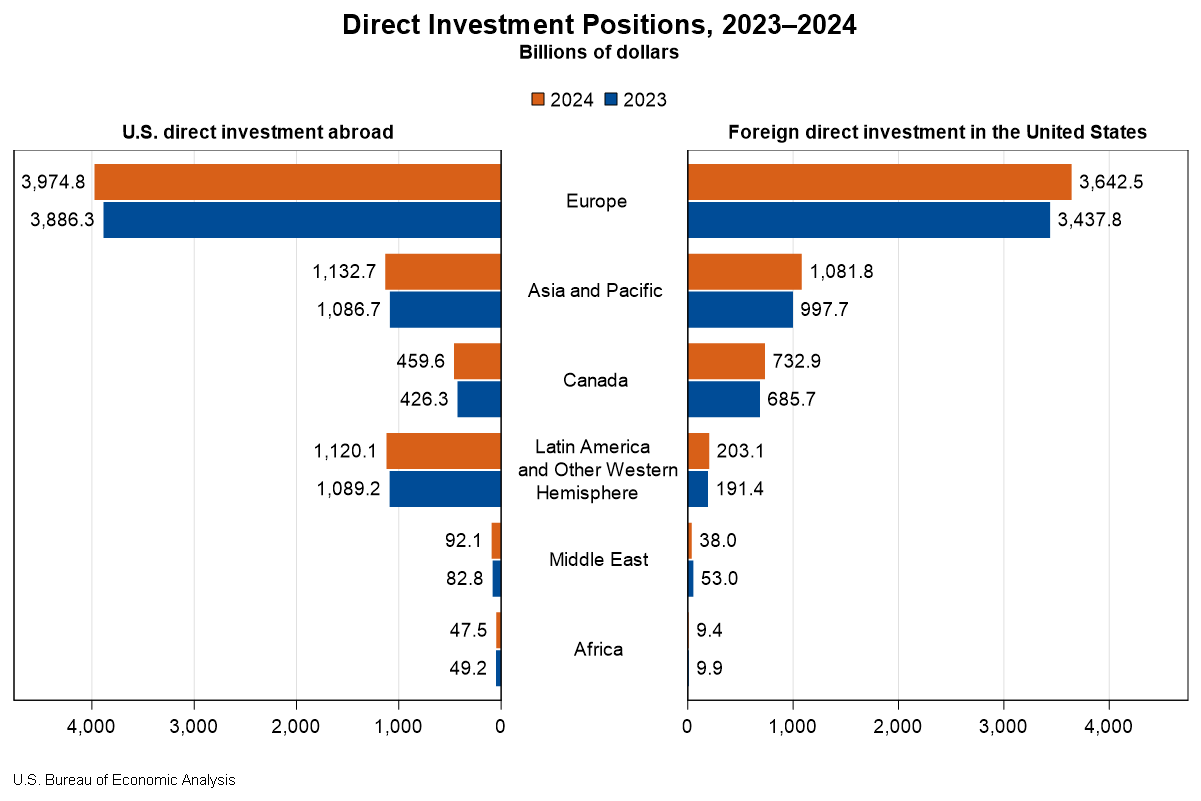Bureau of Economic Analysis
Direct Investment by Country and Industry, 2024
The U.S. direct investment abroad position, or cumulative level of investment, increased $206.3 billion to $6.83 trillion at the end of 2024, according to statistics released today by the U.S. Bureau of Economic Analysis. The increase was led by an $88.4 billion increase in the position in Europe, primarily in Luxembourg and Germany. By industry, manufacturing affiliates had the largest increase, led by manufacturing of computers and electronic products.
The foreign direct investment in the United States position increased $332.1 billion to $5.71 trillion at the end of 2024. The increase was led by a $204.7 billion increase in the position from Europe, which reflected a $52.9 billion increase from the United Kingdom and a $39.7 billion increase from Germany. By industry, affiliates in manufacturing increased the most.
Principal Federal Economic Indicators
Noteworthy
- 2025 News Release Schedule
- Innovation at BEA
- 2025 Annual Updates
- New! Services Trade Data for More Countries
- Data Tool: Trade in Value Added
- Distribution of State Personal Income
- Updated: RIMS II Regional Multipliers
- Arts and Culture
- Space Economy
- FDI Now in State BEARFACTS
- Quick Guide: Price Indexes
The Latest
Gross Domestic Product, 1st quarter 2012 (second estimate); Corporate Profits, 1st quarter 2012 (preliminary estimate)
Real gross domestic product -- the output of goods and services produced by labor and property located in the United States -- increased at an annual rate of 1.9 percent in the first quarter of 2012 (that is, from the fourth quarter to the first quarter), according to the "second" estimate released by the Bureau of Economic Analysis. In the fourth quarter of 2011, real GDP increased 3.0 percent. The GDP estimate released today is based on…
What is the U.S. Bureau of Economic Analysis?
The U.S. Bureau of Economic Analysis, a unit of the U.S. Department of Commerce, is the federal agency responsible for measuring the U.S. economy, or as some say, BEA is the nation’s accountant.
Tracking Foreigners' Spending in the United States
Have you ever wondered what foreigners spend their money on while visiting the United States or what Americans buy while overseas? BEA is often asked for this information, but until recently, didn’t have the means to fully respond. So, we embarked on a research project aimed at finding the answers.
Personal Income Increased 0.4 Percent in March
Personal income in the United States increased 0.4 percent in March after increasing 0.3 percent in February. Wages and salaries rose 0.3 percent in March after rising 0.4 percent in February.
Current-dollar disposable personal income (DPI)—income after taxes—increased 0.4 percent in March after increasing 0.2 percent in February.
Real DPI—income adjusted for taxes and inflation—increased 0.2 percent in March after decreasing…
Personal Income and Outlays, March 2012
Personal income increased $50.3 billion, or 0.4 percent, and disposable personal income (DPI) increased $42.5 billion, or 0.4 percent, in March, according to the Bureau of Economic Analysis. Personal consumption expenditures (PCE) increased $29.6 billion, or 0.3 percent. In February, personal income increased $39.6 billion, or 0.3 percent, DPI increased $29.4 billion, or 0.2 percent, and PCE increased $93.7 billion, or 0.9 percent, based on…
GDP Growth Slows in First Quarter
Real gross domestic product (GDP) increased 2.2 percent in the first quarter of 2012 after increasing 3.0 percent in the fourth quarter of 2011, according to estimates released today by the U.S. Bureau of Economic Analysis.
First-quarter highlights The slower economic growth reflected slower growth in inventory and fixed investment by businesses:
GDP Growth Slows in First Quarter
Real gross domestic product (GDP) increased 2.2 percent in the first quarter of 2012 after increasing 3.0 percent in the fourth quarter of 2011, according to estimates released today by the U.S. Bureau of Economic Analysis.
First-Quarter GDP Defense Spending
In the first quarter of 2012, defense spending declined at an 8.1 percent annual rate, reflecting decreases in compensation of employees (accompanying a drop in the number of active-duty military personnel), in purchases of goods and services, and in investment for defense equipment.
Gross Domestic Product, 1st quarter 2012 (advance estimate)
Real gross domestic product -- the output of goods and services produced by labor and property located in the United States -- increased at an annual rate of 2.2 percent in the first quarter of 2012 (that is, from the fourth quarter to the first quarter), according to the "advance" estimate released by the Bureau of Economic Analysis.




